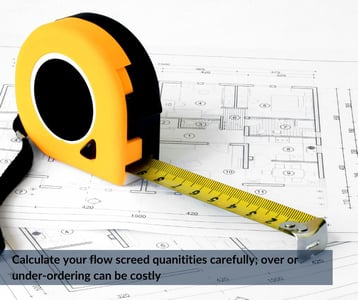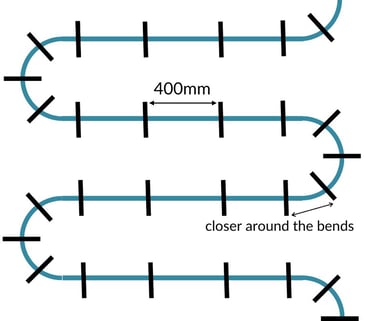Liquid flow screed has become an incredibly popular flooring solution due to the benefits including rapid installation (onsite pouring of around 2000m² per day), incredible savings in labour and time, the supreme level surface it creates and it's effectiveness alongside underfloor heating. As with many construction processes a small error can lead to costly problems such as screed cracking, poor strength or debonding from the substrate. In fact, a report estimates that £10-£25 million is wasted annually on construction errors. With tight deadlines within the industry, there is a tendency to always try and speed up and move onto the next project however rushing can be the number one downfall. If you rush any part of the flow screeding process from planning through to installation and curing, you may encounter some costly problems to resolve. Read on to find out about common mistakes when it comes to liquid screed.
Inadequate Planning
It is vital that you measure your space accurately including factoring in any floor slopes, considering door openings and taking into account the minimum thickness required. Since liquid flow screed comes from ready-mix trucks you will need to calculate your quantities carefully so as not to run into problems. If you over order you may be liable for wastage costs. Under-ordering is equally costly since you will be charged the additional delivery however you cannot guarantee that the material and driver will be available for the additional screed. This also presents problems as the initial screed may already be curing by the time extra screed is delivered which will compromise the quality of the finish and strength.

When planning, all parties involved should be coordinating, this includes the main contractor, screeding contractor and screed supplier, this will ensure timings all go to plan on the day of your install. It is also important to select a liquid screen to suit the environment (e.g. industrial, commercial or residential). Industrial or commercial projects will require more robust materials to account for the frequency of traffic. You'll also find polymer modified screeds available for external installations that need hard-wearing, water resistant properties for demanding environments.
Poor Preparation
Prior to installing your liquid flow screed it is important to ensure your substrate is clean and free from dust and debris so as not to compromise the bond. You must also make sure the area is watertight . You should use a waterproof membrane of at least 1000 gauge which will create a completely sealed polythene pool in which your screed will be placed. It is crucial there is no leakage. Whilst sealing and preparing your area, formwork should be placed around obstacles/pipework to prevent the screed interfering with them. Shuttering should also be installed across doorways and steps.
Underfloor Heating Hints
Underfloor heating works incredibly well with liquid flow screed though there are some key things to remember to ensure heating is installed without any hiccups. Your pipes should be secured correctly (take a look at the diagram below for guidance on how to secure). If a pipe passes through a joint location it must be sufficiently sleeved. Prior to pumping your flow screed, it is good practise to fill your pipes to prevent them floating or being squeezed by the screed. You should gradually pre-heat your underfloor heating before the floor finish is applied but it is vital not to suddenly switch it to maximum temperature.

Ideal Installation
When it comes to your installation day, if you are applying a small amount of screed or a self-levelling screed that requires you to self-mix, make sure the ratios are accurate and mixing is thorough. Self-levelling screed is particularly sensitive to the ratio of water used; too much and it can segregate and crack and too little and it won't level correctly. If you don't mix thoroughly enough, unmixed material can leave weakness in the screed which can even crumble under the weight of heavy furniture/kitchens.

Installation should always take place in the correct weather conditions, over 3°C and rising and under 30°C. It is also key to prime your hoses prior to pumping. Always check your hoses reach the area of installation and do not exceed the maximum hose length specified with your pump. Take care to keep your hoses free from kinks and twists and it is always a good idea to prime your hose to avoid blockages. Find hose primer here at CES.
Drying Dilemmas
The curing process is a critical element of laying your flow screed and frequently causes problems as builders are keen to move on to the next stage and put in the final floor finish. Rushing the drying process can lead to the flooring swelling, buckling and bubbling. Force drying the screed via heat or ventilation often means the floor is prone to cracking . Always follow material data sheets and guidance to ensure you allow sufficient drying time prior to laying your final floor finish.



